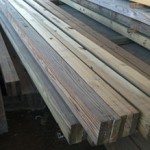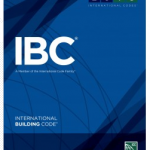We recently had one of our engineers specify the use of glulam pressure treated columns to support one of our custom designed pole buildings. The client was concerned about pressure treated glulams in the ground, so it was time for some heavy duty research.
According to the American Institute of Timber Construction (AITC), structural glued laminated timbers (glulams) can be treated with waterborne preservatives after laminating.
While in general, the laminated timber industry recommends against using waterborne preservative chemicals to pressure treat structural glued laminated timbers after bonding, this recommendation is only intended to prevent appearance problems caused by treatment and subsequent re-drying. Pressure treatment with waterborne chemicals after bonding does not generally make the laminated timber structurally unfit. Treating structural glued laminated timbers (glulams) with waterborne chemicals after bonding may be a viable option for applications where appearance is less critical, like for pole buildings.
 Adhesives used in modern glulams are extremely durable and are considered waterproof. Glulam timbers treated after bonding will accept treatment and resist decay similar to treated sawn timbers of the same species and will perform similarly in service. If the appearance of this product is acceptable to the consumer, it can be used successfully in applications where treated wood is required. Provided the structural requirements of the application are met (meaning – was the right size and grade of pole selected for factors such as wind speed, snow load, etc.), treated glulam timbers can be used in place of treated sawn timbers.
Adhesives used in modern glulams are extremely durable and are considered waterproof. Glulam timbers treated after bonding will accept treatment and resist decay similar to treated sawn timbers of the same species and will perform similarly in service. If the appearance of this product is acceptable to the consumer, it can be used successfully in applications where treated wood is required. Provided the structural requirements of the application are met (meaning – was the right size and grade of pole selected for factors such as wind speed, snow load, etc.), treated glulam timbers can be used in place of treated sawn timbers.
Pressure-treatment is a process of applying preservative chemicals to wood to increase resistance to decay. Pressure-treated wood is used in applications where wood will be wet and subject to decay.
Pressure treatment of properly manufactured structural glued laminated timber members will not cause delamination. Delamination refers to adhesive failure leading to separation of bond lines. Adhesives used in modern glulam products must meet stringent standards for moisture resistance and durability. Additionally, adhesive bonds in glulams must also pass rigorous daily testing for strength and durability. Consequently, delamination is very rare in structural glued laminated timber whether it is pressure-treated after bonding or not. Checks can occur along bond lines due to stress concentrations between laminations and are often mistaken for delamination. The presence of wood fiber separations or torn wood fibers at the bond line is the key distinguishing characteristic of checks .
If glued laminated timbers are treated after bonding, dimensional changes caused by saturation of the wood with the water-borne preservatives and their carrier followed by subsequent re-drying may result in raised grain and warping, checking, or splitting.
Some species do not accept treatment well and require incising while others can be treated successfully without incising. Southern Pine is generally not incised, while Douglas fir typically requires incising for adequate penetration of the preservative.
Bottom line is, can you use glu-lams in the ground for pole buildings if they are pressure treated for in-ground use? Absolutely! The treatment process to get them to the PT level may cause them to look not quite as pretty as the varnished beams in your cathedral ceiling, but they will be every bit as strong. And rest assured…they will not rot. If you don’t believe me – maybe you will believe the American Institute of Timber Construction.










Without a doubt the recommendation by AITC in terms of treating after bonding is accurate. But concluding that bonding treated lumber after treatment falls under that recommendation is an inaccurate understanding of the issue. There are some major issues that can occur with delamination of bond lines in CCA treated lumber. And the problem gets greater as lumber with treatments that have a higher percentage of copper in them are glued. You may find these articles helpful to better understand the entire issue;
https://www.fpl.fs.fed.us/documnts/pdf2006/fpl_2006_lorenz001.pdf
https://128.104.77.228/documnts/pdf1997/vick97b.pdf
It’s been long understood by the glue laminated industry that passing AITC T110 cyclic delamination tests (as required by ANSI 190.1) on CCA treated lumber is more difficult than it is on untreated lumber. It’s also believed that as the retention of treatment increases, so does the delamination. Coupling agents and improvements have been made but the idea that delamination is not an issue is innaccurate. It occurs more often than you may think. As noted in these articles, there are primers that can be used to improve the durability of the bond line of glued treated lumber. One very large glue laminated manufacturer in Minnesota treats their poles and columns after laminating if the retention needs to be greater than .4 (I believe that’s correct) as they have been unable to consistently pass the cyclic delamination tests are required by AITC.
I’ve been involved in a number of cases of delamination on glulam columns.
Hold on here fellas. I think you are talking about two entirely different animals here. What I believe The Guru is talking about is the ability to pressure treat a glue laminated member after it has been glued up. I know of several large manufacturers throughout the US that treat beams and columns after gluing. I am aware that those beams react differently if it is a waterborne treatment or oil born treatment. Our company does not treat glue laminated beams and columns after gluing so I do not want to speculate on how they react differently or what the issues may be. But I personally have never heard of a glue lam beam or column failing because of problems due to delamination on products that were treated after gluing. I think treating after gluing has to be looked at more in depth maybe with the help of an organization such as APA formerly AITC?
In the opening statement of Mr. Mochinksi’s post he expresses some concerns about the Guru’s making an assumption or conclusion that may have been a stretch. We are talking about two products that are totally different animals. I am aware of the study that Mr. Mochinski references and have reviewed it several times. The reality is the study does not find any evidence that supports Mr. Mochinski’s claim that “there are some major issues that can occur with delaminating of bond lines in CCA treated lumber”, – his words not mine. In fact the first sentence of the conclusion of the study states “Our laboratory data indicate that the commercial PRF adhesives were very effective in bonding untreated and CCA treated Lumber.”
When Mr. Mochinski refers to “bonding treated lumber after treatment”- what we call in the industry treating before gluing. I would like to point out he is absolutely correct, that gluing lamina that has already been treated is very difficult. There has to be procedures that are strictly followed when it comes to everything from moisture content of the raw product to face planning the lamina to the correct .008” of an inch. Unlike nailing treated lumber where it can be done in the field or under less than desirable conditions. I have known several post frame builders that nail laminating is the construction of choice because their religious beliefs do not allow them such luxuries as electricity.
It appears that the study Mr. Mochinski is referencing, targets issues with gluing alternative treatments such as ACQ and CA. Therefore I do not recommend laminating lumber that is treated with these types of treatment as per the study.
Dale ~ Thank you very much. It is great to be able to get input from an expert who actually manufacture thousands upon thousands of glu-laminated columns!
My comments regarding delamination of treated lumber are based upon data and information provided to me by the former owner of Alamco. Without a doubt his expertise in this subject involved 100’s of thousands, if not in the millions of glue laminated products shipped all over the world. They’re position on gluing CCA treated lumber that needed to pass a cyclic delamination test was that as long as the retention was .40 or less, they knew they could pass their cyclic delamination tests. Products that they manufacture with higher retention levels than .40 were treated after laminating. Alamco is now owned by Bell Pole and Lumber and to the best of my knowledge still follows the same criteria.
Both studies referenced in my post above are done by objective industry experts and both have CCA treated lumber in them. My comments are based upon that data, not personal experience in the manufacture of glulam.
The first sentence of the conclusion is clearly the result of Table 1 in which the results of the cyclic delamination test are done. On that table you will see that when CCA is primed, it does pass the cyclic delamination tests performed in this study. Without it, it does not.